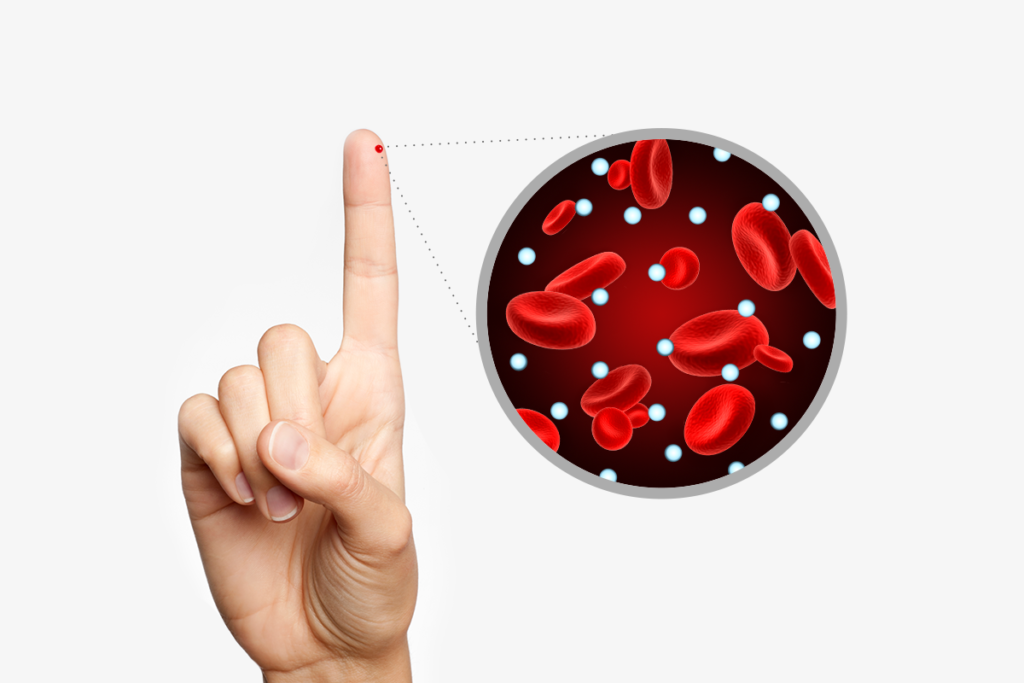Prediabetes Symptoms, Risk Factors, Diagnosis & Treatment
Reviewed by: Melissa Herrmann Dierks , RDN, LDN, CDCES
Many people have elevated blood glucose levels without realizing they have prediabetes. Prediabetes can be hard to detect, however, knowing the risk factors can help you determine if you’re at risk and should be screened for prediabetes.
A prediabetes diagnosis should be taken seriously. It is an opportunity to introduce healthy lifestyle changes to prevent your blood glucose levels from becoming higher in the short term and sometimes long term. Lifestyle changes are typically easier to manage and provide greater health benefits early in the progression of insulin resistance. So, detecting diabetes and taking preventative measures early on is vital to improve lifetime blood glucose management.
In this article, we cover the following topics related to prediabetes:
- What is prediabetes?
- How prediabetes affects your health
- Prediabetes screening and diagnosis
- Prediabetes treatment and preventing type 2 diabetes
- Outlook for people with prediabetes
What is prediabetes?
Prediabetes is a very common condition, affecting as many as 88 million adults in the US, according to the Centers for Disease Control and Prevention (CDC). Blood glucose levels in people with prediabetes are often higher than they should be, but not high enough to be diagnosed as type 2 diabetes.
The elevated blood sugar levels associated with prediabetes are an indicator that cells in your body have developed an impaired response to insulin — a hormone produced by your pancreas to regulate blood glucose. If left untreated, this impaired response, called insulin resistance, can increase your chances of developing type 2 diabetes.
Prediabetes (formerly known as borderline diabetes) can be further classified as “impaired glucose tolerance” and “impaired fasting glucose“ based on whether your blood sugars are elevated above a normal range first thing in the morning, and/or at random times of the day.
Working with your healthcare team to take early and ongoing preventative actions while in the prediabetes stage can help prevent or delay the onset of type 2 diabetes.
How prediabetes affects your health
The higher than normal blood glucose levels associated with prediabetes increases your risk of type 2 diabetes, heart disease, and stroke.
While having prediabetes does not automatically mean that you will go on to develop type 2 diabetes, there are numerous factors associated with type 2 diabetes that can lead to other serious health problems like heart disease, kidney disease, nerve damage, and vision loss.
If prediabetes progresses to type 2 diabetes, this can impact a person’s life in many ways, such as:
- Adding regular blood glucose checks to the day
- Increasing medical expenses
- Requiring medication or insulin, in some cases
- Long-term health complications
Nearly all people with type 2 diabetes have previously had prediabetes, which oftentimes goes undetected. In order to detect prediabetes, you need to know the risk factors and be proactive about consulting your healthcare professional (HCP) if you believe you’re at risk.
Prediabetes screening and diagnosis
The majority of people who have prediabetes don’t know they have it — that’s over 84% of people — according to the CDC. The good news is that there are methods to screen for prediabetes and indicators that you may be at risk.
Prediabetes symptoms and risk factors
Many people do not experience symptoms of prediabetes, which makes it difficult to know that the condition is present. Symptoms associated with diabetes typically show up once prediabetes has become type 2 diabetes. However, knowing the factors that put you at risk for prediabetes can help you determine if you should be screened for it.
The American Diabetes Association (ADA) lists the following risk factors for prediabetes:
- Age of 45 or older
- Ethnicity is Black, Hispanic/Latino, American Indian, Asian America, or Pacific Islander
- A history of diabetes in your immediate family (parent or sibling)
- Being overweight
- Being physically inactive
- High blood pressure or taking a medication for high blood pressure
- Low HDL cholesterol and/or high triglycerides
- Previously had gestational diabetes
- Diagnosed with Polycystic Ovary Syndrome (PCOS)
Additionally, children and young adults may be at risk for developing prediabetes. A CDC study found that about 1 in every 5 children (aged 12-18) and 1 in every 4 adults (aged 19-34) are living with prediabetes. The findings of the study also indicated that males and participants with obesity accounted for a larger percentage of the children and young adults with prediabetes. Ethnicity appeared to also play a role with higher rates of prediabetes in Hispanic young adults compared to white young adults.
Early detection is an opportunity to reverse prediabetes or prevent or delay the onset of type 2 diabetes. If you think you may be at risk, take a risk test and be proactive about getting screened.
Testing for prediabetes
There are three common blood tests used for prediabetes:
- A1C: This test shows your average blood glucose levels over the past three months. You do not need to fast for this test.
- Impaired fasting glucose (IFG): After fasting for about eight hours, this test shows your current blood glucose level. It is also known as the fasting plasma glucose test.
- Impaired glucose tolerance (IGT): Your blood glucose is tested before and two hours after you drink a liquid containing glucose. This test requires fasting to establish a fasting blood glucose level, and a longer appointment. This test is less often used to detect prediabetes and type 2 diabetes.
To be screened for prediabetes, talk with your HCP about your risk factors. Screenings can be performed by your HCP or at some pharmacies that offer free clinics to test for chronic conditions.
Prediabetes A1C range, fasting glucose, and glucose tolerance results
Each test for prediabetes has different criteria to classify your results as either normal, within the prediabetes range, or diabetes. Your physician may use these ranges, or recommended ranges published by the American Diabetes Association or the American College of Clinical Endocrinology.
The CDC considers the following results for each blood test to be within the prediabetes range:
| A1C | IFG | IGT |
| 5.7% – 6.4% | 100-125 mg/dL | 140-199 mg/dL |
Prediabetes treatment and preventing type 2 diabetes
Although prediabetes is a risk factor for type 2 diabetes, early intervention and participation in a lifestyle change program approved by your healthcare team can lower your risk of developing type 2 diabetes — as much as 58% for adults younger than 60 and 71% for those over age 60.
With healthy lifestyle changes, it’s possible that you can prevent or delay the onset of type 2 diabetes. The lifestyle factors that can have an impact on your diabetes management are diet, exercise, and weight. Every little bit of improvement in these areas can help.
Eat a healthy, balanced diet
Choosing nutritious foods and appropriate portion sizes can help you maintain improved blood glucose levels. This doesn’t mean you have to do away with your favorite foods. You can work with a Registered Dietitian Nutritionist (RDN) to come up with a prediabetes diet plan that incorporates the foods you like while eating healthy, balanced meals.
The ADA recommends these quick tips for a healthier diet:
- Avoid or cut back on sugary drinks like soda and juice. Try having water or a calorie-free drink.
- Have at least 2 ½ cups of vegetables every day.
- Choose fruit over cookies, cake, or pie.
- Opt for roasting, grilling, broiling, steaming, or baking food instead of pan frying or deep frying.
- Use healthy oils like canola, olive, and vegetable.
- Avoid foods high in saturated fat.
Adjusting your prediabetes diet with healthy changes can help your body better respond to insulin, which can make your cells become more effective at absorbing glucose. This can help in delaying the onset of type 2 diabetes and improving blood sugar.
Stay active
Exercise is also pivotal to improving how your body responds to insulin. According to an article published by the ADA, regular aerobic activity can increase insulin sensitivity in people with diabetes. Even light-moderate daily exercise of at least 10 minutes can have glucose-lowering benefits, particularly when performed after a meal and when sitting for a prolonged period of time.
Aerobic activities consist of continuous and repeated movement of large muscle groups. Some examples are walking, running, cycling, and swimming. To make exercise fun, consider trying one of these:
- Start a fitness challenge with friends, family, or coworkers.
- Listen to an audiobook or a podcast.
- Go for regular walks with a pet. If you don’t have a pet, local shelters oftentimes are in need of volunteers to walk dogs.
If you have not been active recently, be sure to start slowly and consult your HCP for individualized advice on how to introduce physical activity in a healthy way. They may recommend a cardiac stress test before recommending an increase in activity.
Maintain a healthy weight
In addition to a healthy diet and regular activity, achieving a healthy weight early in the progression of insulin resistance can improve glucose levels. According to the CDC, if you are considered overweight, losing a modest amount like 5-7% of body weight can lower the risk of prediabetes progressing to type 2 diabetes.
It is possible to take a weight-neutral approach to improving blood sugar. By working with a registered dietitian nutritionist, customized meal plan guidelines can be created to provide consistent carbohydrate distribution throughout the day, helping to improve blood sugar levels no matter what your weight. Partnering the diet changes with even ten minutes of walking after each meal can help lower your A1C.
Losing weight — if overweight — in combination with eating a healthy diet and daily exercise can offer the greatest benefits for prediabetes glucose control, as weight loss alone may not always improve glucose levels. If your goal is to lose weight, meet with a registered dietitian nutritionist who can help you set a realistic weight goal based on your weight history, age, overall health, and more.
It’s always best to discuss lifestyle changes with your HCP to make sure your goals are aligned with what is best for your health.
Join a diabetes prevention program
Diabetes prevention programs offer a more structured way for people with prediabetes to make lifestyle changes. The CDC-recognized National Diabetes Prevention Program provides in-person or online support for learning healthier eating habits, adding physical activity into your life, managing stress, and staying motivated. Participants who meet their goals in the program have shown to reduce their risk of developing type 2 diabetes.
Outlook for people with prediabetes
A person with prediabetes may go on to develop type 2 diabetes, but that is not always the case. Be persistent about improving activity levels, eating habits, and weight if able, for the best chances of improving prediabetes glucose levels and delaying the onset of type 2 diabetes.
Checking periodically for type 2 diabetes may be recommended by your HCP. The ADA recommends that people with prediabetes get screened for type 2 diabetes every 1-2 years. It is also good to be on the lookout for symptoms of type 2 diabetes, which include:
- Excessive urination and thirst
- Extreme fatigue
- Blurry vision
- Unexplained weight loss
- Numbness in your hands or feet
- Slow-healing cuts or bruises
If you notice any of these symptoms, it is important to set up an appointment with your HCP to determine if you should be screened for type 2 diabetes.
Lifestyle factors and early detection play a key role in controlling high blood sugar levels that can lead to type 2 diabetes. By being proactive about getting screened and following a prediabetes treatment plan under your healthcare team’s guidance, you’ll be on your way to improving your overall health.




![Meal Planning for Diabetes: How to Optimize Your Diet [Free Meal Plan Chart]](https://agamatrix.com/wp-content/uploads/2019/08/Diabetes_Meal_Planning_Feature_Image.jpg)